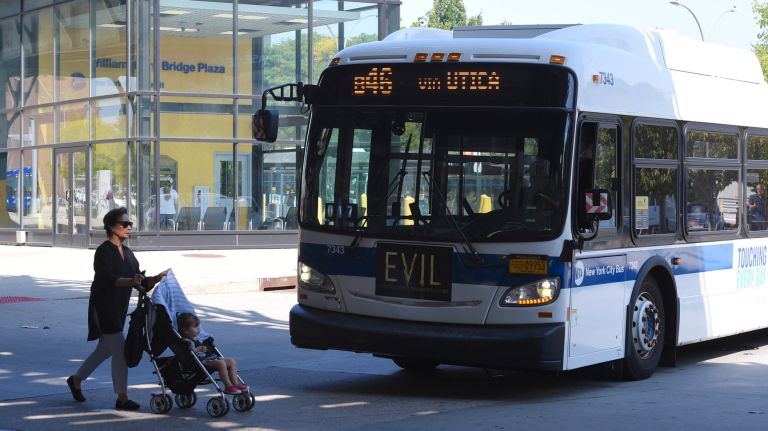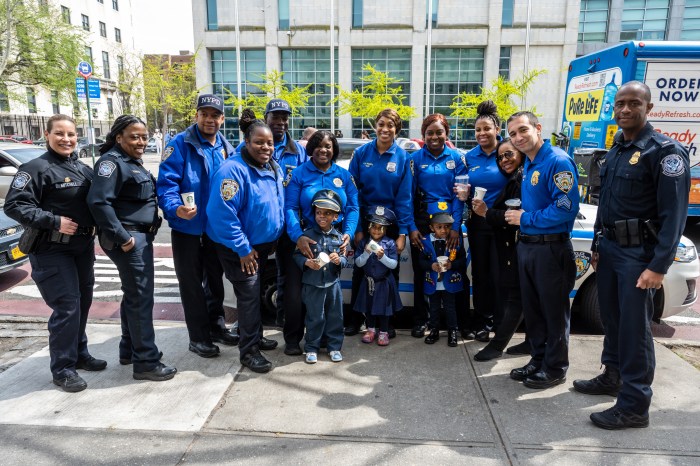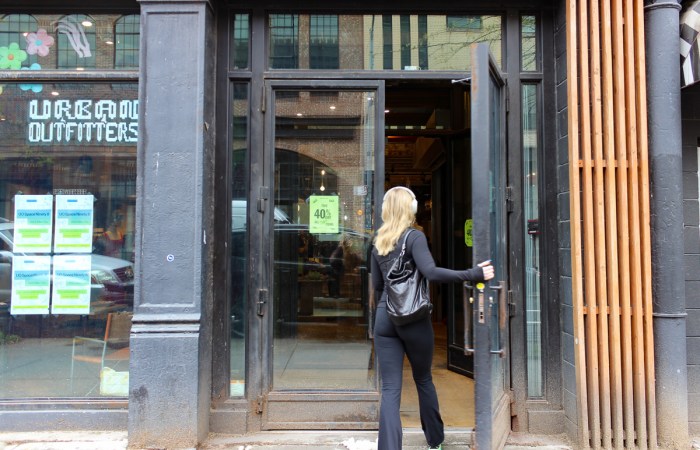
Buses are crawling across city streets at a slower clip than last year, despite months-old promises from the city and the MTA to improve service.
NYC Transit President Andy Byford laid out a bus plan in April 2018 and Mayor Bill de Blasio made faster buses a key pillar of his State of the City address this January — but the rides have remained abysmally slow, stuck in mounting traffic.
Average MTA bus speeds in the city are actually trending slightly down over the last year — from 8.2 miles per hour to 8.1 miles an hour — when comparing August 2019 to the same time last year, despite those full-throated commitments to improve the slowest bus service among major American cities.
The average speeds dropped most significantly on Staten Island, from 16.8 mph in August 2018 to 13.9 mph in August this year. In Manhattan, they dropped from 6.1 mph to 6 mph., and in Queens, from 9 mph to 8.9 mph. Average speeds remained the same in Brooklyn (7.2 mph) and the Bronx (7.6 mph).
While the MTA, a state authority, operates the bus network, the city controls the streets on which it runs. Advocates put the onus on the de Blasio administration to do better.
“Improving bus speeds is really a team effort, but in New York it’s like our coach has been off dawdling on his presidential campaign and some of the teammates are really phoning it in,” said Ben Fried, spokesman for the nonprofit TransitCenter. “I would single out the city and the NYPD — we really have no indication that they’re getting the existing bus lanes to function better.”
De Blasio during his address announced a sweeping plan to improve average bus speeds by 25% — from 7.44 miles per hour to 9.03 miles per hour — by the end of 2020. He pledged an unremorseful tow truck team tasked to remove drivers parked in lanes, to more quickly implement technology that reduces wait times for buses and traffic signals and to increase the number of bus lanes installed each year.
“Buses are a critical link in our public transportation system, and we’re doubling down on improvements to help get New Yorkers moving,” de Blasio said at the time, following up in April with a more detailed “Better Buses” action plan.
Eight months after that State of the City, advocates say the mayor appears checked out from overseeing what they see as credible proposals.
Despite pledging a dedicated tow team to enforce bus lanes, the number of summonses issued to bus lane blockers has plunged when compared to figures from last year. Police issued 3,867 summonses for bus lane violations through August, according to city data. That’s a 37% decrease from the 6,156 bus lane violations issued through July of last year. (Comparable data for August 2018 is missing from the NYPD’s web archive.)
The NYPD’s dedicated bus route towing team has towed 1,763 vehicles that were obstructing the flow of traffic in bus lanes since last November, according to police.
A Department of Transportation representative said that the city “expects further announcements this year on different bus projects.”
“[When] Mayor de Blasio announced the Better Buses plan … in April, we committed to installing 10-15 miles of bus lanes per year, implementing projects that will benefit 600,000 daily riders,” the DOT representative said. “Announced only five months ago, the impact of many of these changes has not yet been felt in MTA data that capture systemwide bus-speed trends over the entire last year.”
Bus riders might get some good news amid potentially devastating service cuts in the offing.
The MTA announced Monday it will begin testing automated bus lane enforcement on Oct. 7 with new forward-facing, bus-mounted cameras on several routes, beginning with 51 buses on the M15 SBS. Later in November, the pilot will expand to two other routes.
“Automated bus lane enforcement is a critical part of our plan to increase bus speeds, because transit priority improvements do not work if motorists do not respect their purpose or abide by traffic laws,” Byford said. “We need to give our buses every fighting chance to get through the city’s congested streets.”
The city and MTA hope the enforcement cameras, coupled with the forthcoming congestion pricing program in Manhattan and a plan to introduce all-door bus boarding, will help dramatically increase speeds. But all-door bus boarding won’t be feasible until around February 2021, once the MTA launches its new fare system, OMNY, across the entire bus network.
As bus ridership has slowed, the MTA has implemented service cuts on several bus lines as it attempts to save money and close a $1 billion budget gap forecast for 2022. The authority reduced service on 11 routes in May, another three routes in July and, coming this January, will do so on the busiest route in Brooklyn, the B46 Select Bus Service.
The MTA is reducing the frequency of arrivals on the B46 SBS, a critical lifeline for its 38,120 weekday riders, and instead running longer, articulated buses. The MTA argued that the service change on the route between Mill Basin and Bedford-Stuyvesant will ultimately add more seats for riders, but it also translates to a 40% reduction in service during the evening rush hour.
Riders fumed at the change.
“With the B46, there’s a bus every five minutes, and it’s always packed, so there is a need for more buses,” said Susan Frankson, 47, a culinary instructor from Weeksville, Brooklyn. “This is an important bus, because it goes to Kings Plaza and there are apartments all along there … with people who don’t have cars. They need it or they’re stuck.”
MTA Chairman Pat Foye has warned that more severe cuts could be coming soon, alarming advocates who believe lagging service coupled with greater reductions would lead to a “death spiral” where New Yorkers abandon the bus.
Board member Veronica Vanterpool on Monday questioned how the MTA prioritizes service against less necessary features. The cuts to the B46 SBS are expected to save the MTA $2.4 million annually — about the same as the $2.5 million the MTA spends each year to provide Wi-Fi through its New York City Transit bus network.
“Are we suggesting Wi-Fi is more important than the service we provide to those customers?” Vanterpool asked at a committee meeting.
Byford responded that he’d always prefer to preserve service and promised that even though the MTA is in a “bad place” with its budget, he would do everything to avoid more serious cuts.
“What we’re not talking about is cutting routes,” Byford said. “I really don’t want to go there, but we are in real difficulty in the short- to medium-term on our operating budget unless we can get some form of sustainable, dependable additional operating spending stream.”
With Ivan Pereira


















